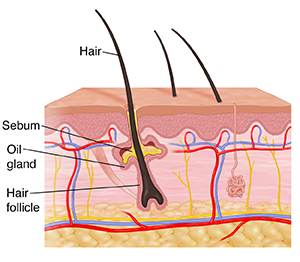What Is Teen Acne?
What Is Teen Acne?

How you get acne
Acne begins inside the hair follicles under the surface of your skin. Oil glands that open into the hair follicles release too much oil (sebum). This is often due to hormonal changes. Sebum and skin cells then clog the tiny openings on your skin (pores). Bacteria can then get trapped in the follicles, leading to swelling and acne blemishes. Acne is not caused by the food you eat or drink—for example, chocolate or soda.
Types of acne
The 4 main types of acne blemishes are described below:
Whiteheads are round, white blemishes that form when hair follicles become clogged.
Blackheads are round, dark blemishes that form when whiteheads reach the skin's surface and touch air.
Pimples are red, swollen bumps that form when plugged follicle walls break near the skin's surface.
Deep cysts are pus-filled pimples. They form when plugged follicle walls break deep within the skin. Acne cysts are often large and painful. In some cases, they also cause scars.
What your healthcare provider can do
Some teens see their healthcare provider for their acne because they are upset by the way their skin looks. Ask your provider about the best way to control your specific type of acne. Treatment helps prevent blemishes and scars from forming. If no new blemishes form, no new scarring can occur. Medicines can and will improve your acne, but it often takes several months, not several days. If you stop taking the medicines, the acne will usually recur. Treatment may include:
Medicines taken by mouth (orally)
Medicines applied to the skin (topical)
Physical removal of blemishes
Laser therapy or chemical peels
Surgical removal of acne scars
Make sure you understand your treatment plan. If you have any questions, ask your healthcare provider. You will play an important role in controlling your acne.
Updated:
June 15, 2018
Sources:
Pathogenesis, clinical manifestations, and diagnosis of acne vulgaris. UpToDate.
Reviewed By:
Image reviewed by StayWell medical illustration team.,Lehrer, Michael Stephen, MD,Sather, Rita, RN